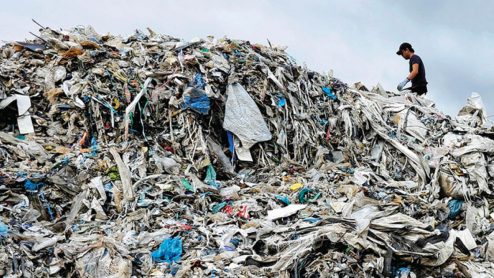An ambitious Global Plastics Treaty could halve plastic production emissions, EIA analysis finds
Planet-threatening greenhouse gas emissions due to plastics production could be halved over the next 25 years if there is a freeze and reduction in the production of plastic polymers.
While the use of fossil fuels is the primary cause of the climate crisis, plastic polymers are manufactured using by-products of the gas, coal and oil industries. These polymers, the basic ingredient from which all plastics are made, are also a major contributor to global warming and plastic pollution.
 According to the new EIA report Addressing the Issue Head-On – Measures on polymer production in the Global Plastics Treaty, halting overall polymer production, coupled with measures to target the most dangerous (PVC, polystyrene, and polyurethane) while placing limits on plastics produced in high quantity and which result in most waste (such as polyethylene, polypropylene and PET), could reduce annual plastic production by 64 per cent.
According to the new EIA report Addressing the Issue Head-On – Measures on polymer production in the Global Plastics Treaty, halting overall polymer production, coupled with measures to target the most dangerous (PVC, polystyrene, and polyurethane) while placing limits on plastics produced in high quantity and which result in most waste (such as polyethylene, polypropylene and PET), could reduce annual plastic production by 64 per cent.
In the run-up to the fourth round of Global Plastic Treaty negotiations (INC-4) in Ottawa, Canada, from 23 April, EIA used data to model a series of scenarios and discovered that by curbing plastic production:
- greenhouse gas emissions could be reduced by at least 25-47 billion tonnes of carbon-dioxide equivalence during 2025-50
- plastic waste that has been mismanaged, incinerated or ends up in landfills could be reduced by 7.1 billion tonnes over the same period
- but if polymer production continues on a ‘business as usual’ basis, up to a further 17.7 billion tonnes of plastic is predicted to be produced during the next quarter of a century.
As current levels of polymer production are incompatible with limiting long-term temperature rise to 1.5C – crucial to help avoid the most damaging impacts of climate change – delegates are also being urged to support a transition to a genuine circular economy, a model addressing production and consumption by focusing on reusing, repairing and recycling existing materials for as long as possible.
EIA Ocean Campaigner Jacob Kean-Hammerson said: “Our hypothetical modelling exercise using newly reported data clearly demonstrates that addressing plastic production needs to be part of the solution to the plastic pollution and climate crisis.”
EIA is urging the 175 international governmental delegates negotiating the treaty to take strong action and address the issue of plastic production head-on.
“It’s a sure-fire way to move towards a safer, more circular economy for plastics, reduce waste generation and crucially reduce greenhouse gas emissions,” added Kean-Hammerson.
More than half of all plastics ever made have been produced in the past 10 years and single-use plastics make up to 40 per cent of all production.
At present, a circular economy for plastics is unachievable without urgent action, given the abundance of low-cost virgin plastic which is cheaper to produce than recycling used plastics, coupled with a lack of regulation and transparency in the supply chain.
“We have to begin to reduce the amount of plastics we are producing year on year,” said Kean-Hammerson. “At the moment, we are on an exponential growth trajectory and it’s unfathomable that in 25 years we will produce 17.7 billion tonnes of plastic and 15 billion tonnes of waste – yet that is where we are heading.”



